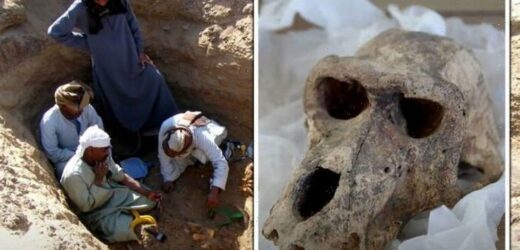Ancient Egypt: Zoo animals found buried alongside an early ruler
We use your sign-up to provide content in ways you’ve consented to and to improve our understanding of you. This may include adverts from us and 3rd parties based on our understanding. You can unsubscribe at any time. More info
Ancient Egyptian history has attracted archaeologists from all over the world. The Western world only found out about the advanced ancient civilisation that inhabited the banks of the River Nile in the mid-1880s. It was then that English Egpytologist William Matthew Flinders Petrie began his work, discovering fragments of a colossal statue of Ramses II, an Egyptian pharaoh.
While archaeologists local to Egypt had been working in the country long before Mr Petrie, it was his work that popularised Egyptology and earned him a knighthood.
We now know that the pharaohs began ruling in Egypt in 3,000 BC, when Upper and Lower Egypt were united.
They were eventually abolished in 343 BC, but by this time had established themselves as the land’s immortal kings.
While this was an ancient civilisation in all senses of the world, society in Egypt goes back even further, beyond the great pharaohs.


Prehistoric Egypt spans the period from the earliest human settlement to the beginning of the pharaohs, where kings ruled over their subjects.
In 2015, archaeologists digging at Hierakonpolis, the religious and political capital of Upper Egypt at the end of the prehistoric era, came across a relic that had never been found before.
Their finds were explored during the Smithsonian Channel’s documentary, ‘Secrets: Beasts of the Pharaohs’.
Renée Friedman, an archaeologist who has carried out extensive work in the area, discovered an array of animal carcasses sourced from across the continent of Africa in the ancient complex.
Further investigations made by her team indicated that the animals had been kept in captivity and fed by humans, like pets.
JUST IN: Archaeologists stunned by ‘fascinating’ Iron Age ‘time capsule’

For Ms Friedman, there was only one feasible explanation: “In essence, here we have the world’s first zoo.
“This dates back over 6,000 years ago.
“This is before even the invention of writing, before the invention of the potter’s wheel.
“This is before pyramids were even a glint in some king’s eye.”
Much of Egypt’s religious iconography would stem from the animals in the zoo, making up the country’s legendary artistic style and also influencing the culture of later kingdoms.
DON’T MISS
Archaeology breakthrough as underground slave escape network found in [REPORT]
‘Discovery of the century’ World’s largest pterosaur found in Scotland [INSIGHT]
London breakthrough ‘once-in-a-lifetime’ Roman mosaic found near Shard [ANALYSIS]


Ms Friedman said: “We’ve been able to get dates on our animals now from what they had for their final meal.
“This has allowed us to get carbon for 14 dates, which has been showing us that many of these animals were buried all at the same time, because the dates are almost identical.”
Oddly, the animals that were kept did not die of natural causes.
They were instead all slaughtered and buried with their owner whenever he died.
Standing over the grave of one ruler, Ms Friedman explained: “This ruler, like the other ones we have here, had a number of animals with him.

“So we have a leopard, we have baboons, we have an oryx, we have a crocodile, and we have an ostrich.”
The burial process was carried out in order to ensure that the animals’ mystic powers would accompany a ruler to the afterlife.
Animal carcasses were not the only skeletal remains found at the site, however.
The remains of women and children were also found.
Ms Friedman explained: “At a funeral, everybody went together.

“That means both the animals and the humans were accompanying the ruler to the next life.”
Around the area, the remnants of coloured wooden posts were found, suggesting that the tombs were at one point housed by structures.
A reconstruction saw a lavish complex raised from the ground, showing a main tomb sitting in the centre alongside the human burials which would have been laid out all around.
Surrounding that were all the animals, forming a belt of protection around the ruler.
Source: Read Full Article


